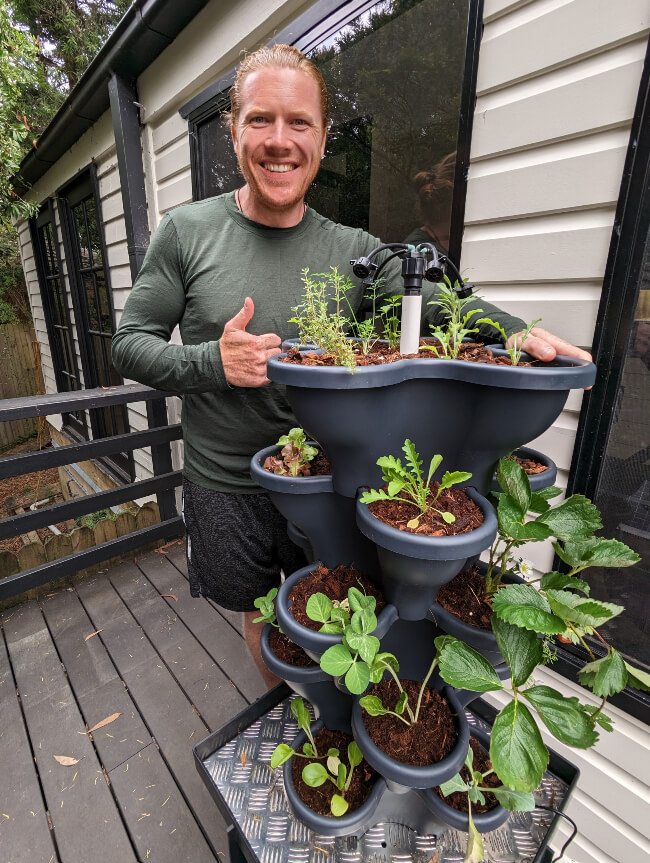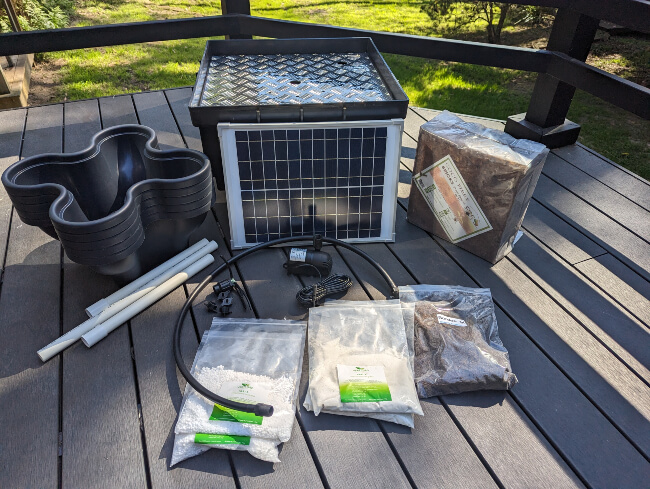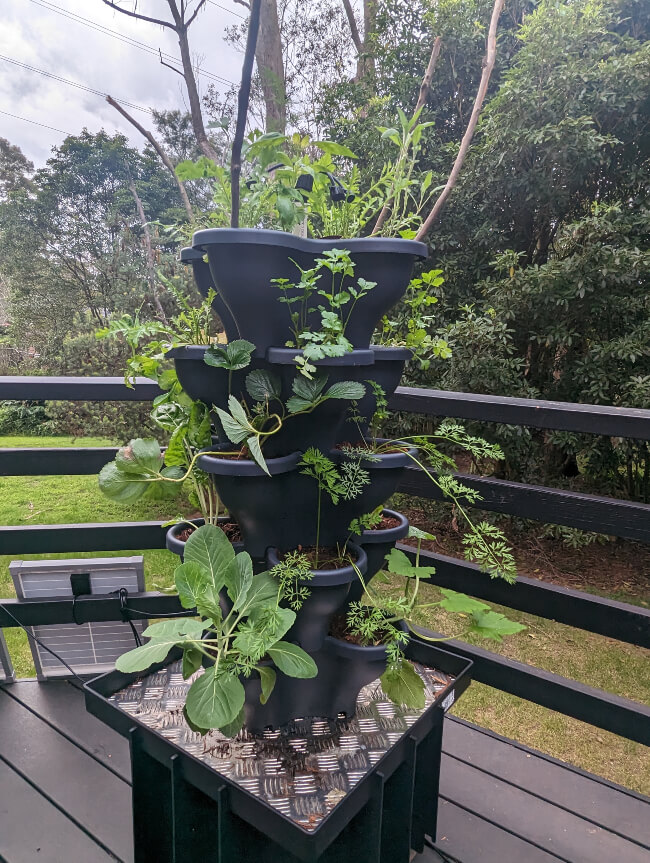Verti Gro’s Solar Eco Farm is a fantastic addition to the vertical gardening and hydroponics marketplace. It’s not just easy to use, it actively changes how we think about hydroponics, how to use them, and their benefits.
In basic terms, the Verti Gro system uses a traditional self-watering setup, but rather than working with standing water, it circulates water from a central tank at the base, ensuring constant aeration, movement, and circulation of moisture and nutrients during daylight hours – and it does it all using a single, compact, solar panel.
More...
You can watch our video review of the Verti Gro Hydroponic Solar Eco Farm, where Nathan from Aussie Green Thumb shows us how to set up the garden, a progression of the plants growing over a few months, and his honest thoughts on the system.
Introducing the Verti Gro Solar Eco Farm

Verti Gro’s Solar Eco Farm uses inert coir compost to provide a growing medium and adds nutrients to that growing medium, and to a small reservoir under each planting pocket, just like a traditional hydroponic setup.
However, its reservoir is neatly separated from the coir, and it provides so much coir and root space, that it’s effectively the same as growing using self-watering wick-system pots, but with much less effort.
By using the technology and sterile benefits of hydroponics, and the root space of self-watering planters, this simple system means you can grow completely organic food, using fewer nutrients than most other types of vertical planters.

Nathan Schwartz of Aussie Green Thumb approving the Verti Gro Hydroponic Farm
How does the Verti Gro Solar Eco Farm work?
The central tank, at the base of the tower, is filled with water and can be decorated with pebbles, gravel, or even wood chips to help retain humidity during particularly hot days.
Once filled, the tank uses a solar panel to power a small pump, which circulates water up to a drip system at the top of the unit.
As the drip system pours water down through the top planter, it fills a reservoir beneath each plant, and when full, overflows to the planter below, eventually getting back to the tank and recirculating nutrients and water until they are used up.
What can you grow in the Verti Gro Solar Eco Farm?
One thing that always gets me about vertical gardens is how good they look. In any garden, they quickly become as much an ornamental feature as they are a productive tool.
If you want to lean into that, then grow gorgeous leafy greens like coloured red chard, leaf beets, or edible peacock kales, with beautiful frilly white foliage that looks as good as it tastes.
If you’re more focused on being productive, try growing peppers, eggplant, or tomatoes for faster harvests than in pots or raised beds, or be ambitious and aim big with zucchinis, pumpkins, and melons, which will all thrive in vertical gardens on a warm balcony or patio.


Get Your Free Guide:
Master Growing Australian Natives eBook
A Must Have Complete Guide for Every Australian Garden
Get Your Free Guide:
Master Growing Australian Natives eBook
A Must Have Complete Guide for Every Australian Garden
For constant use of greens from your garden, try planting a range of herbs and leafy greens, which grow fast and can be harvested multiple times.
We grew a range of greens and veggies, and all grew very well in the system. This included; zucchinis, cabbages, carrots, strawberries, bok choy, pak choi, snow peas, rocket, different types of lettuces, and a range of herbs including thyme, dill, parsley, corriander, oregano, mint and sage.
What you get with your Verti Gro Solar Eco Farm kit
The kit itself is actually incredibly simple, with everything set up for you. All you have to do is unbox it, stack it in the right order, and you’re good to go. We’ve put the whole system to the test and inspected everything you get in the box too.
Check below for more detailed information about what you get, and why it’s there.

5 x large Verti Gro Australia planters & valves
There are five planters, each with four large planting pockets, meaning there’s space to grow either several hundred cut-and-come-again salad plants, or 15 tomatoes (or single large plants).
That might not seem like much, but for a comparable amount of food out in the garden, you’d need 1m per tomato plant, meaning 15m squared of outdoor space, instead of just 1m of patio for this compact planter.
Each planter has a valve included, which stops the growing medium blocking the reservoirs and allows water to circulate freely.
Base tank & lid
The base tank isn’t the nicest looking tank out of these sorts of kits, but it’s probably the most durable, with strong ribbed sides to make sure the plastic tank never bows out in the hot summer sun (a common problem on some cheaper versions of the kits)
PVC pipe, connectors & drippers
PVC pipe is durable and long-lasting, but more importantly, cheap to replace and flexible, so if you ever need to change the system or accidentally damage it, you can replace it with PVC pipe from any DIY store for less than $10.
The connectors provide stability and security for the tiered planters, while the drippers are designed not to clog up, and provide constant running water while the sun is hitting the solar panel.
Solar Panel & pump
If you’ve ever come across these types of kits before you’ll probably be familiar with the tiny solar panels that come with them. Quite frankly, they are very rarely large or efficient enough to power the pump, so it’s a relief to see a compact, but effective solar panel included with the Verti Gro Solar Eco Farm, ensuring reliable working hours from most of spring, summer, and autumn as a bare minimum.
Growing medium
Coco coir is a fantastic growing medium for any hydroponic system and works well in this hydroponic system too. What’s even better though is that it's incredibly affordable and available in most DIY stores, garden centres, and online, so whenever you’re ready to plant up your next crop, it’s easy to get hold of. To start with, you'll get a huge 5kg block of coco coir with your Verti Gro kit, which is plenty to fill the planters.
Nutrient & fertiliser
You get a choice of nutrients and fertilisers with this kit, and you will need to replace them quite regularly, but they are sold by the kg so they last reasonably well, and if you like experimenting, you can make your own hydroponic feeds to save money in the long run.
Installing the Verti Gro Solar Eco Farm
Getting to grips with your new Verti Gro Solar Eco Farm is simple, especially with the straightforward manual that comes with it, along with plenty of online support and tutorial videos too.
You can watch our video which shows Nathan setting up the system to get an idea of what's involved.
The only real challenge is making sure you’ve found the best possible location for the garden, as you will need the plants to receive 3-8 hours of sunlight per day.

How to Install the Verti Gro Solar Eco Farm
Before you start building your vertical tower, there is a super easy check you can do to find the best spot in your garden. To start, take the pump and solar panel out of the box and fill a small bucket with water.
Then simply move the bucket and panel around the garden, checking for where the water pressure is highest. At different times of day, it will change, so try checking at about 1 pm for the best sunlight indication.
After that, follow the instructions to set up the reservoir, install the pump, planters, and central supports, and you’re pretty much ready to go.
Using the Verti Gro Solar Eco Farm
Make sure the planting pockets are clean and free of debris, then fill them with growing medium, and add perlite which comes with the kit.
Sow directly into each pocket (sowing instructions will vary depending on what you’re growing), and then turn the system on by putting the solar panel in the sun.
Once the system is set up, the process is the same on day one as it is on day 365. Every 2-4 weeks, add a fresh supply of water to the reservoir, add nutrients and test pH regularly to make sure the water is suitable for what you’re growing.
Other than that, you can sit back and relax, and enjoy your veggies.
Verti Gro Solar Eco Farm Frequently Asked Questions
What is the Verti Gro Solar Eco Farm designed for?
Like everything from Verti Gro, the solar Eco Farm is designed with initial tests for success based on how well strawberries grow, and is then adapted to ensure successful growth of a range of greens and vegetables. They are most useful for small spaces or for gardeners wanting to maximise their veggies operations.
How much does the Verti Gro Solar Eco Farm cost to run?
Because the Verti Gro solar Eco Farm is solar-powered, it costs nothing to run, but you will need to buy regular nutrients, feeds, and pH adjusters to make sure your system is clean and nutritious enough for plants to thrive.
What’s the biggest benefit of vertical gardening?
The biggest benefit of vertical gardening has to be pest and disease resistance, especially with hydroponic towers, which provide well-aerated water, constantly managed nutrients, and make sure your plants are more resistant to pests, and isolated from soil-borne bacteria.
Looking into different growing options? Check out our in-depth guide on garden irrigation systems to if this is the right one for you.
Wrapping Up Our Verti Grow Solar Eco Farm Product Review
Verti Gro is a dedicated garden supply company, focused on producing top-quality vertical gardens inspired by their own vertical strawberry gardens in Phillip Island, Gippsland, in Victoria. It’s not just that these products work, it’s that they’ve come from literally years of trial and error.
So the team that built them, designed them, and continues to manage their sales, know what they’re doing, and care just as much about making vertical gardens that work as you do – because their farming livelihood depends on the success of their hydroponic vertical gardens.
So that’s our take on the Verti Gro Solar Eco Farm, but the proof is in the crop, so the rest is up to you!
Published on April 19, 2023 by Nathan Schwartz
Last Updated on July 18, 2023




